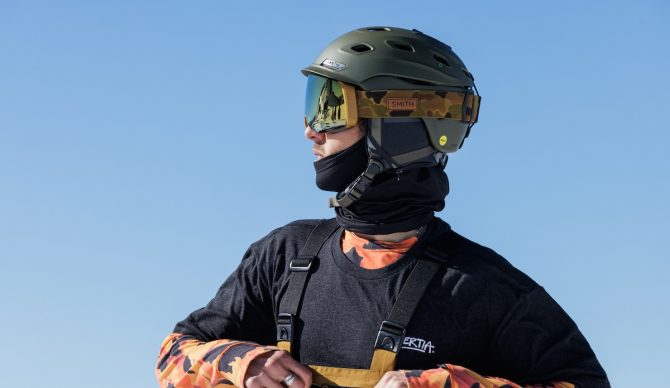
The bottom of the Smith’s 4D Mag goggles curves inwards for a better downwards-facing field of view. Photo: Tim Manning//The Inertia
One of the most underrated and overlooked parts of a snowboarding setup is a good pair of goggles. But really, it’s one of the most important pieces of equipment you’ll own. The ability to see properly in all weather conditions is critical to a safe and enjoyable time on the hill.
Yes, it’s true – good goggles really do make a difference. Here is a list of our favorites from over the years, with a collection of tried-and-true classics as well as some brand-new innovations. This article is the result of putting more than 20 pairs of goggles through their paces over the past two winter seasons. We took these snowboard goggles out in all conditions, from bluebird powder to stormy wet days, cold mid-winter blizzards, and glorious, sunny spring park laps.
After testing, we found the Best All-Around Snowboard Goggles to be the Smith I/O Mag with top-tier Chromapop lens technology and a wide variety of comfort and fit options, but if you’d rather save cash than shell out for special features, check out the Glade Adapt 2, our Best Value pick, or our Best Budget pick, the Smith Frontier.
Navigate To: Comparison Table | How We Tested | Buyer’s Guide
Related: Best Snowboards | Best Snowboard Pants | Best Snowboard Jackets | More Winter Reviews
Editor’s Note: We most recently updated this article on November 19, 2025, giving our buyer’s guide a minor overhaul, adding links and information covering alternative fit and size options for our top-pick goggles, and updating our Best Budget pick, the Smith Frontier, which is being replaced this season with the Smith Transfer and smaller-sized Smith Tribute.
The Best Snowboard Goggles
Best All-Around Snowboard Goggles: Smith I/O Mag
Best Field of View: Smith 4D Mag
Best Value Snowboard Goggles: Glade Adapt 2
Best Budget Snowboard Goggles: Smith Frontier
Best for Smaller Faces: Oakley Flight Deck M
Best Features: Anon M5
Best All-Around Snowboard Goggles
Smith I/O Mag ($283)
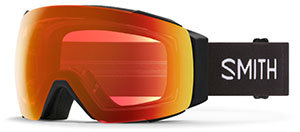
Size/Fit Options: S, XL, Low Bridge, S Low Bridge, XL Low Bridge
Lens Shape: Spherical
Pros: A variety of shapes and colors for the ideal combo
Cons: Not easy to change lenses without getting fingerprints on them
You can’t go wrong with a classic. Smith has been the leading brand in snowsports goggles for a while now, and with good reason. The brand’s lens tech, called ChromaPop, is one of the best (neck-and-neck with Oakley’s Prizm), as is the lens-changing system, durability, and fit.
Smith’s I/O Mag has seen a number of updates over the years, and this year it’s available in three different sizes (Regular, S, and XL), as well as a Low Bridge Fit, S Low Bridge, and XL Low Bridge. The magnetic lenses are easy to change, but also have a secure locking mechanism at the temple to ensure you don’t lose that fancy lens in the powder. The 4D Mag has recently taken over from the I/O Mag as Smith’s flagship offering, with the enhanced downwards field of view provided by the unique lens shape.
However, some users have experienced fit issues with the design, so for those who want the best of the best in lens quality and comfort, the I/O Mag still reigns supreme. These goggles come with an extra lens and a soft goggle sock to keep your goggles protected while not in use. Thanks to the top-tier quality you’re getting here, along with the relatively competitive price point compared to other high-end goggles like the Smith 4D Mag, Anon M5, and Dragon NFX Mag, we awarded these goggles the Best All-Around Snowboard Goggles for 2025. Read our full review of the Smith I/O Mag Goggles here.
Check Price on BACKCOUNTRY Check Price on Smith
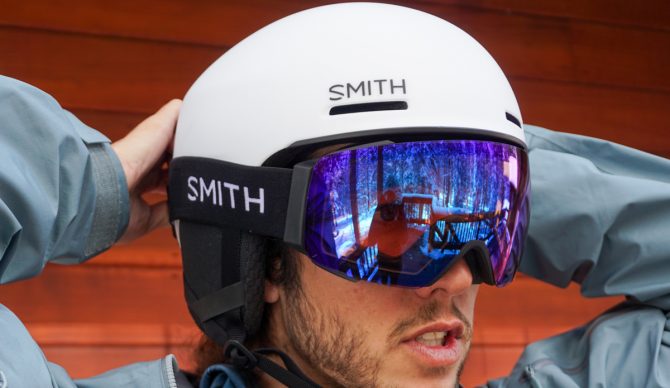
Photo: Ken Cox//The Inertia
Best Field of View
Smith 4D Mag ($348)
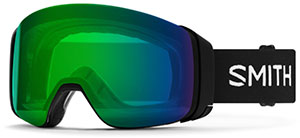
Size/Fit Options: 4D XL, 4D S, Low-Bridge, XL Low-Bridge, S Low-Bridge
Lens Shape: D-shaped custom design
Pros: Beautiful lens quality, ample color options
Cons: Pricey, some fit issues
If you’ve got the dollar to shell out for it, the 4D Mag is the best of the best when it comes to field of view and lens clarity. For the best vision on the mountain, look no further. The shape of the goggles fits seamlessly with Smith’s helmets for better airflow, reducing fog. The magnetic lens-changing system is quick and easy, and we found it’s even possible with gloves on. Where these goggles really shine, though, is the field of view. The 4D lens design curves sharply inwards at the bottom, giving the wearer an increased downward field of view, all the better to see what’s going on under your skis or board in front of you. And despite the wide field of view, the goggles don’t seem bulky, and it seems most companies have learned from the oversized spherical trend from about 10 years ago that sometimes, less is more.
What pushed the 4D Mag into the “Runner Up” position rather than “Best All-Around” was two things – first of all, the price, as they’re a full $40 more expensive than other top-of-the-line options. Second of all, the modified frame design at the bottom of the goggles is a bit hit-or-miss for our testers – some found these goggles to be extremely comfortable, while others weren’t fans. With that in mind, Smith now offers custom-fit goggles, guaranteeing an incredible fit, for those who can shell out for it. Furthermore, this season, Smith launched the 4D XL for larger faces. The goggles are also available in a low-bridge fit, and new this year, they’re available in a photochromic lens as well, which adapts to the light and costs $30 extra at $378. Read our full review of the Smith 4D Mag here.
Check Price on Smith Check Price on Backcountry
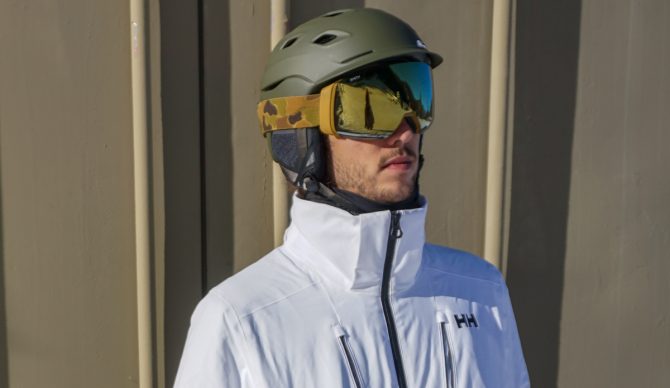
Photo: Ken Cox//The Inertia
Best Value Snowboard Goggles
Glade Adapt 2 ($150)
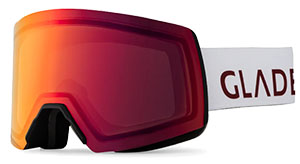
Size/Fit Options: Adapt 2S, Low-Bridge, S Low-Bridge
Lens Shape: Cylindrical
Pros: Lens tint changes with the light conditions
Cons: Strap isn’t as durable as others, oversized fit won’t work for smaller faces
Photochromic lenses have come a long way in the past few years. For those who aren’t familiar, they operate like a pair of transition glasses, starting off with a fairly light tint and getting darker in bright light. The transition used to be slow and gimmicky, and the lenses often didn’t have the range to excel in either very bright or dim conditions. That’s changed, and the Glade Adapt 2 is a prime example.
Glade’s photochromic quickly reacts to varied light conditions and has a huge VLT range of (in the goggles we tested) 16 to 61%. The tint-shifting lenses weren’t annoying while tree skiing, performed great on sunny days, and were up there with the best of them in dim conditions. On flat-light days, the lens tech wasn’t quite as incredible as Smith or Oakley, but they certainly did the job. The goggles have a bit of an oversized fit that looks good on a wide range of faces. For narrower and smaller faces, the Adapt 2S are the same goggles with a scaled-down fit.
We awarded these the best value snowboard goggles, thanks to the competitive price point and how the photochromic lens adapts to a wide variety of conditions without the need for a second lens (which often raises the price point). New for 2025/2026, Glade has introduced a new REVEAL 4K contrast-boosting technology, similar to other lens techs like Smith Chromapop, that can be chosen as an option on the Glade website, and increases the price by $20.
Check Price on Glade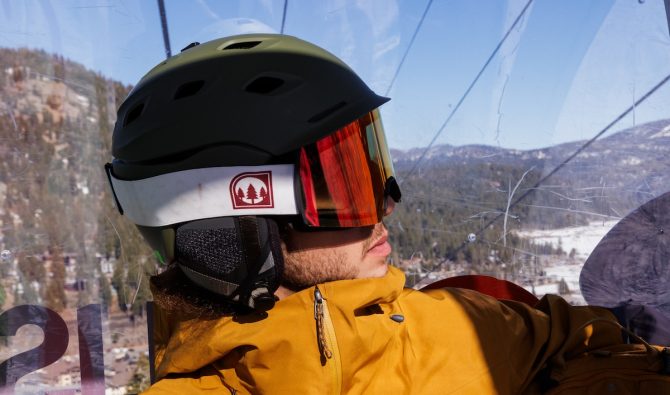
Photo: Tim Manning//The Inertia
Best Budget Snowboard Goggles
Smith Frontier ($55)
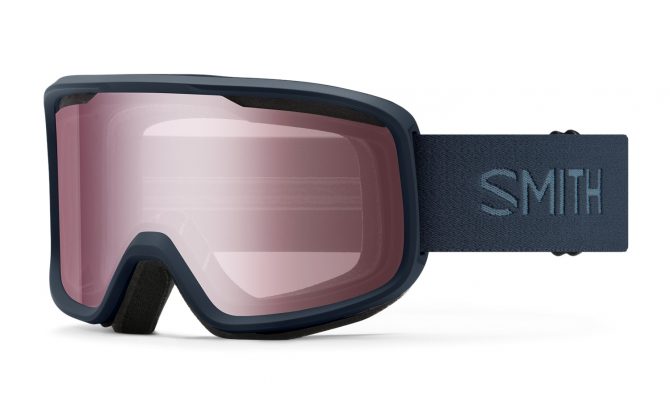
Lens Shape: Cylindrical
Pros: Cheap as chips, Smith’s reputation for quality gear
Cons: Smaller field of view, lenses aren’t easily interchangeable
Editor’s Note: Smith is replacing the Frontier this season with the Transfer and smaller-sized Tribute, which both retain a similar low price of $58. Upgrades include two-layer, instead of one-layer foam, and more lens options to match a wider array of conditions. We’ll update this review as soon as we test the new styles.
Smith really does have the entire field of snow goggles on lock, from the top-tier options to the dirt-cheap budget variety. And when it comes to making a pair of goggles that do what they are supposed to without getting in the way of you having a fun time, the Smith Frontier has what it takes to get the job done without breaking the bank. These goggles are as simple as it gets, with a cylindrical lens and single-layer foam. At this price point, you’ll miss out on features such as Chromapop (Smith’s contrast-boosting technology), and quick lens-changing ability, but the reduction in price is significant, and if you’re only getting out a couple of times a season, or want to dip your toes into the world of snowsports without breaking the bank, these are an incredible option.
Where these goggles do shine is in their dependability. They are not overly prone to fogging, and the lens, with a VLT of 36%, is a great middle-ground option that will perform well in a wide variety of conditions. It won’t be a top performer in low-light or ultra-sunny conditions, but as a solid all-rounder, it’s a great choice. For a bit more tech (magnetic lens-changing, additional lens options) at the same price point, without Smith’s top-tier reputation, check out the Outdoor Master Pro goggles, further down in this review.
Check Price on BackcountryAnother Top-Tier FOV Contender
Oakley Flight Deck M ($225)
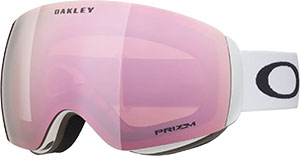
Size/Fit Options: Flight Deck L
Lens Shape: Spherical
Pros: Incredible lens quality and field of view
Cons: No low-bridge fit, only one lens included
Before the Smith 4D Mag came around, the Oakley Flight Deck was a strong contender for the “Best Field of View” award. With a massive cylindrical lens, frameless design, and Oakley’s top-tier lens quality, there is really very little to complain about. However, the 4D Mag does edge things out somewhat in terms of downwards-facing FOV, which pushes the Flight Deck a bit further down the list.
The Flight Deck is a smaller frame than the Line Miner, yet the spherical shape allows for a huge field of view. This means great vision without swallowing your face. The Flight Deck M is what we’d recommend for smaller faces, but Oakley also makes a size L for those who want the same ridiculous field of vision in a larger frame. Both styles have Oakley’s famous Prizm lens tech, the same as the Line Miner, above, which ranked highest for clarity and sharpness. These are the goggles that ski race champion Mikaela Shiffrin uses, so if you have the need for speed, these just might be the pair for you.
Check Price on Backcountry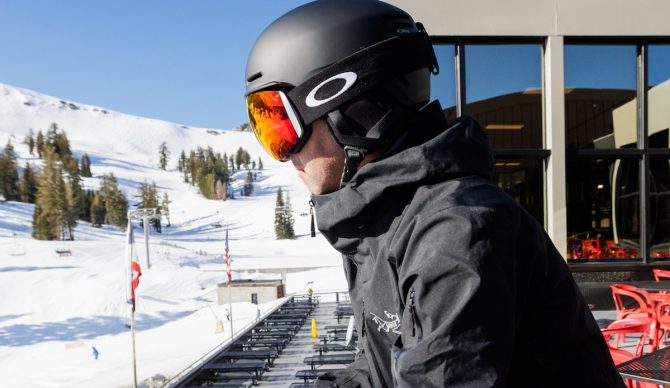
Photo: Tim Manning//The Inertia
Best Additional Features
Anon M5 ($315)
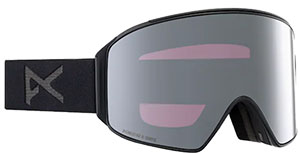
Size/Fit Options: M5 S, Low-Bridge, S Low-Bridge
Lens Shape: Toric
Pros: Comes with a bonus lens and facemask
Cons: Lens doesn’t lock in place
The Anon M5 is a sweet setup all around, and you can’t go wrong with the optics and comfort. But what sets them apart is the bonus accessories. The goggles come with a facemask that attaches magnetically to the bottom of the goggles, giving a seamless fit and keeping more snow out of your schnoz. And while most goggles come with a bonus lens, the Anon M5 has its own protective case for the extra lens that will keep it safe in your pocket while shredding around. When the time does come to change, the spare lens will be well cared for in its second home and on your face in seconds, thanks to the magnets.
Even more innovative is the new toric shape of the lenses. Basically a hybrid between a cylindrical and spherical shape, a toric-shaped lens is apparently the most similar to our field of vision. While it’s not directly noticeable, it’s more of a subtle difference where you don’t notice a flaw in the vision, rather than seeing something you normally don’t see. Plus, it doesn’t bulge out like big spherical lenses, meaning less chance of scratching.
Check Price on Backcountry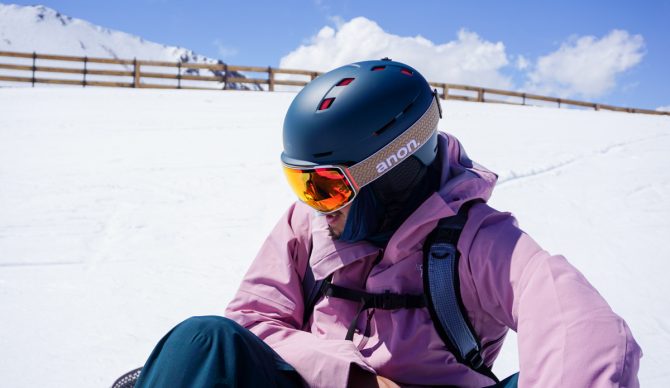
Photo: Will Sileo//The Inertia
Best of the Rest
The above are our top picks, but there are a lot of awesome and tech-packed glass out there on the market to get your hands on. From budget picks to fun and interesting options, here are a bunch of other goggles that will serve you well while snowboarding.
Best OTG Goggles/Runner-Up Best All-Around
Dragon NFX MAG OTG IR ($299)
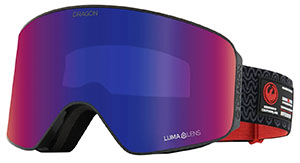
Lens Shape: Cylindrical
Pros: Easy lens change, infrared light filtering
Cons: Limited color options
Everyone talks about UV light, but what about infrared? On the other side of the light spectrum is the often-neglected infrared radiation, which, after a while, can lead to eye problems such as cataracts. This is especially true in bright light situations, and now Dragon has a lens that filters out 99% of infrared light with the NFX MAG OTG IR (IR stands for infrared). We aren’t scientists, but from an average rider’s perspective, it does feel a lot nicer on the eyes on bluebird days where the sun reflects at you from all angles. It’s definitely worth noting, especially for those who spend a lot of days out in the bright sun, year after year.
There are many ways to change a lens, and it’s safe to say the folks at Dragon have it nailed. They combine magnets with a locking system to ensure security as well as ease of transition. As great as the magnetic lens systems are, they are always a bit of a concern when wiping out. The Dragon Swiftlock system addresses this once and for all. The magnetics allow for a quick change, and with a flick of a switch, they are locked to the frame, allowing one to go huge without fear of a lens being lost in the snow should you take an unfortunate tumble.
Additionally, these goggles have a larger frame, allowing those of us with glasses to wear them underneath. These are definitely a solid choice for those who want to keep all lenses close to themselves, especially for those of us who aren’t afraid to take a tumble but might be afraid of the walk of shame to the shop needing to replace a lost lens. As you’re shopping, just be aware that the violet-lens colorway is the only one sporting the new infrared technology – look for the “IR” designation to make sure you’re getting what you want. Read our full review of the Dragon NFX MAG OTG IR here.
Check Price on BackcountryTime-Tested Quality
Oakley Line Miner ($176)
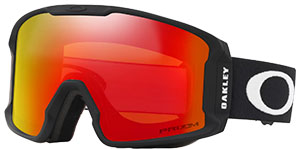
Size/Fit Options: M, L
Lens Shape: Cylindrical
Pros: Amazing vision, decades of research
Cons: No fast change, only comes with one lens
Let’s face it — Oakley has been around for a while, so it’s probably no surprise if you’ve ever tried a pair of goggles or sunglasses from the brand. And if you have, I’m sure you’d find it hard to disagree that they seem to have clarity and color both on lock. Looking through Oakley’s Prizm lens is like an extra layer of definition. Sure, Oakley will have a story as to what sets it apart, but all we can say is that it works and works well. Isn’t that all you need? It’s right on par with Smith’s ChromaPop, so for a significant amount less, you still get great lens clarity, albeit without the swapability and second lens that comes in Smith’s top-tier offerings.
The Line Miner brings back the classic cylindrical lens for a lower profile fit and to reduce that “bug-eyed” look that comes with spherical lenses. These are the goggles of choice for pro snowboarders like Mark McMorris and Ståle Sandbech, and that’s because they look good, have a great field of vision, and Oakley’s Prizm tech delivers in spades when scoping lines and landings. And for a premium goggle, while we hesitate to call this a “budget option,” $161 is not too shabby. The Line Miner doesn’t have the same quick-change system as others on this list (the lens can be swapped out if needed) and only comes with one lens, but we can certainly appreciate the simplicity of the design.
The Line Miner comes in a few different sizes for different faces. Our tester went with the Line Miner L, but smaller faces will appreciate the scaled-down Line Miner M.
Check Price on BackcountryRunner-Up Best Budget
OutdoorMaster Pro Goggles ($45)
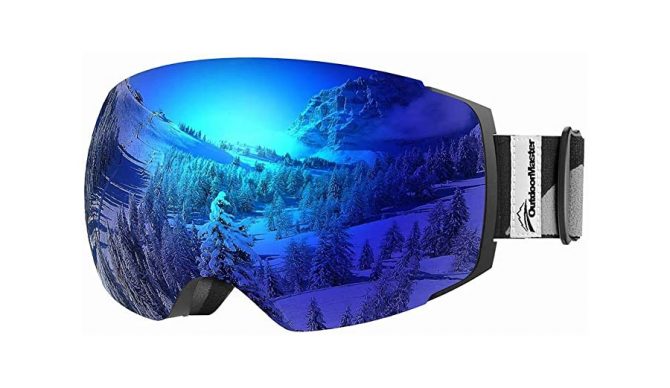
Lens Shape: Spherical
Pros: Cheaper than the gas it’ll cost to get you to the hill
Cons: Lenses aren’t anything fancy
If you’re really not interested in the top-tier options and are looking for the best dirt-cheap pair of goggles on the market, OutdoorMaster’s Pro Goggles fit the bill nicely. The Pro goggles are designed to help you see well in all conditions and feature a magnetic interchangeable lens system that makes swapping out lenses a breeze.
Available in twenty different lens colors, the goggles also feature UV400 protection and enhanced polarized lenses that protect your eyes and allow you to see clearly. These goggles are comfortable and fit well. For the price, we’re very impressed with the performance. Sure, it’s not Smith’s ChromaPop or Oakley’s Prizm tech, but for a mere sixth of the price of some options on this list, you simply can’t be expecting top-tier features. The main challenge with these goggles is that the magnetic lens system doesn’t lock, so the goggle lenses are prone to coming out on a heavy crash or when stashed in a bag. Long-term durability takes a bit of a hit, too, with the frameless spherical lens feeling a bit exposed.
CHECK PRICE ON AMAZONMost Comfortable Goggles
Sweet Protection Durden RIG ($160)
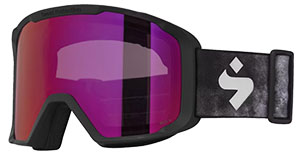
Lens Shape: Cylindrical
Pros: Super comfortable foam
Cons: Lenses don’t change as easily as others
Norwegian company Sweet Protection started out making helmets for kayakers, which could be a clue to its innovations in comfort. There was just something really nice about the way that the Durden RIG goggles fit our tester’s head. Maybe it’s the foam, maybe it’s the shape, but there was a certain je ne sais quoi (or however you say that in Norwegian) that can only be summed up with the notion that when it feels right, it feels right. Even in the wet coastal conditions, the foam did a great job of wicking away moisture, and they felt dry to the touch all day.
We also found Sweet Protection’s lens technology (called RIG) to have some of the best contrast in flat light conditions. It’s a darker lens, but it still lets the highlights in, allowing for plenty of definition to come through. And if you have a Sweet Protection helmet, you’ll get a seamless fit with the goggles and avoid the dreaded “gaper gap”.
Check Price on BackcountryInnovative Frame Design
POC Nexal ($270)
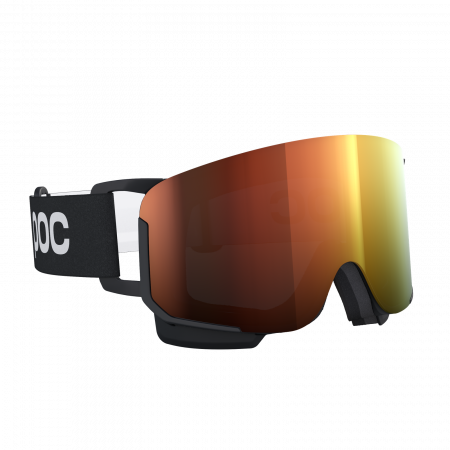
Lens Shape: Cylindrical
Size/Fit Options: Mid
Pros: Frame outriggers reduce pressure on the face, extra face coverage under the lenses
Cons: Frame outriggers can make the fit feel loose
POC’s Nexal Goggles are one of the most interesting styles we’ve tested this year. With extra panels below the lens to provide more face coverage to protect from wind chill, sun, and impacts. They’re also said to provide a similar amount of glare reduction as the eye black used by professional athletes in sports like baseball and football.
And that’s not all that’s different about these goggles. Flexible plastic frame outriggers extend from either side of the lens, which are said to improve fit with POC helmets, allowing the goggles to sit as close to the face as possible. In testing, we found the main difference with these outriggers to be how they reduce the pressure against the face that one often feels with a tight-fitting pair of goggles. That can be a pro or a con depending on your preference – less likely to leave you with goggle marks around your eyes, but we also found it can lead to a looser feeling with a bit more pressure on the forehead portion of the goggles than the cheekbones. Not so loose as air would get in around the frames, but it’s definitely a different feeling compared to other goggles we’ve tested.
The final unique feature is that the vents on the upper portion of the goggles are adjustable, and can be closed for “reducing airflow when skiing at higher speeds.” As helmet users, we didn’t find this to be a make-or-break feature. In terms of lens-tech, POC’s Clarity tech provides comparable performance to our favorite lenses, such as Smith’s Chromapop and Oakley’s Prizm tech.
Check Price on BackcountryDragon X2S ($229)
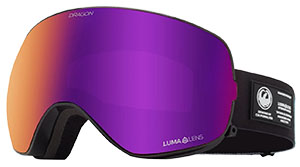
Lens Shape: Spherical
Pros: Large field of view, great fit
Cons: Lens changing can be finicky
Our women’s snowboard goggles tester spoke very highly of the Dragon X2S goggles due to both comfort and field of view. “The thick foam was like a warm hug,” she says. Comfort is key. The spherical lens also stood out, as well as the previously mentioned Swiftlock lens changing system that allows for quick lens changing on the fly without missing a beat, even in a snowstorm.
Plus, with a bunch of fun colorways, it’s easy to get things dialed, not that that’s everything, but who are we kidding, it’s important to both men and women, and should be with the type of coin you’re dropping! So get these if you value comfort above all else, yet don’t want to sacrifice your peripheral vision or the ability to change lenses in a matter of seconds. After continued testing, we bumped the Oakley Flight Deck M goggles up to the top spot for smaller faces, given the ridiculous field of view that you get with such a small frame, and Oakley’s top-tier Prizm tech, which is, along with Smith’s Chromapop, one of our favorites for seeing clearly in all conditions.
Check Price on BackcountryGiro Contour Goggles ($270)
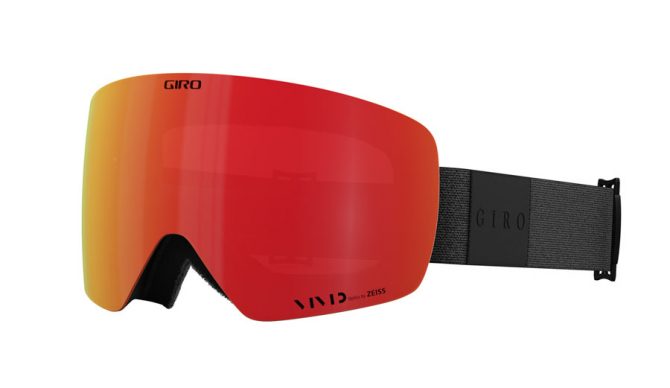 Size/Fit Options: RS
Size/Fit Options: RS
Lens Shape: Spherical
Pros: Great fit
Cons: Frame does not protect the lens
Giro’s Contour goggles pack a punch. To ensure optimal clarity, the goggles feature lenses with Zeiss technology and an awesome venting system to prevent fogging. Additionally, the goggles include a quick-changing magnetic lens system, with snap pins to ensure the lenses don’t budge, so you can easily swap out lenses according to conditions.
Our favorite feature of the Contour is the frameless design, which allows for incredible peripheral vision. However, as a result, the frame does not protect the lens quite as well as on many other goggles we tested. The price may be a bit steep, but these goggles hit all the marks, and then some. Designed for riders with a smaller face, the Contour RS is a slightly smaller design than the original Contour model, allowing for that perfect fit.
Check Price on BackcountryPit Viper French Fry ($69)
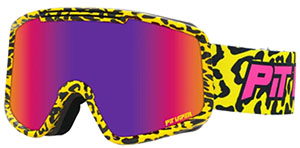
Lens Shape: Cylindrical
Pros: Mad style, great price
Cons: No high-tech or mention of sustainable materials
Pit Viper easily wins the “best marketing” category if we ever cared to make one. Although our goal here at The Inertia is to cut through the marketing fluff, Pit Viper knows how to speak to the hearts of skiers and boarders through a nostalgic throwback to simpler times, where the only way to text your friends at school was by passing handwritten notes, and the only screen time you had was playing Drug Wars or Snake on your graphing calculator.
So when the company began its foray into snow goggles, we had to try a pair. Are they the most high-tech goggles on our list? Definitely not. Is there a strong chemical smell when you open the box? Most certainly. Is the style nothing like you’ve seen before? You tell us, but it’s a safe assumption that you haven’t.
Clocking in at a smirk-worthy $69, the French Fry goggles are PV’s basic offering, but they do the job they are intended to do – they keep the snow and sun out of your eyes long enough to get down the hill. You can’t swap the lenses like a premium pair like Pit Viper’s ProForm, and they don’t filter the light as well as top-tier lenses, such as Smith’s ChromaPop or Oakley’s Prism tech. Where they really shine is in the style category, so if you want to stand out, the French Fry is what you’re looking for.
CHECK PRICE ON EVOHonorable Mentions
There are too many awesome snowboard goggles on the market for us to include them all in this guide. With that in mind, here are some other options we tested that came oh-so-close to making the list. First off is the POC Vitria ($260) with a top-tier spherical Zeiss lens and an oversized frame for a great field of view. However, we found the oversized frame to be a bit large for most. We’d also like to call out the Electric Kleveland ($150), a solid bang-for-buck model with a great field of view and lens clarity, but it misses out on features like lens-swapability. Finally, the Scott React ($250) goggles come with an awesome lens-changing system and nice extras like a slimmed-down hard case to protect your spare lens while it’s stashed in your backpack; however, we found they fit a bit small on medium-large faces.

Pairing a helmet and goggles from the same manufacturer ensures a snug fit and (hopefully) solid ventilation to boot. Photo: Steve Andrews//The Inertia
Snowboard Goggles Comparison Table
| Goggles | Price | Lens Shape | Features |
| Smith I/O Mag | $275 | Spherical | Extra lens, magnetic change system |
| Smith 4D Mag | $340 | Custom D-Shape | Amazing optics, good ventilation when used with Smith helmets |
| Glade Adapt 2 | $150 | Cylindrical | Photochromic lens |
| Smith Frontier | $55 | Cylindrical | Cheap and reliable |
| Oakley Flight Deck M | $225 | Spherical | Crazy field of view for a small-sized goggle |
| Anon M5 | $300 | Toric | Magnetic facemask, extra lens with hard case, magnetic change system |
| Dragon NFX Mag Infrared | $300 | Cylindrical | Easy magnetic change system, extra lens, infrared protection |
| Oakley Line Miner | $166 | Cylindrical | Classic looks, extra lens |
| Sweet Protection Durden RIG | $150 | Cylindrical | Comfy foam, great value |
| OutdoorMaster Pro | $45 | Spherical | Dirt cheap |
| POC Nexal Clarity | $240 | Cylindrical | Frame outriggers, adjustable vents and extra face protection |
| Dragon X2S | $239 | Spherical | Scaled-down Dragon for smaller faces, Swiftlock lens change with extra lens |
| Giro Contour Goggles | $270 | Spherical | Zeiss lenses |
| Pit Viper French Fry | $69 | Cylindrical | Unique style, great value |
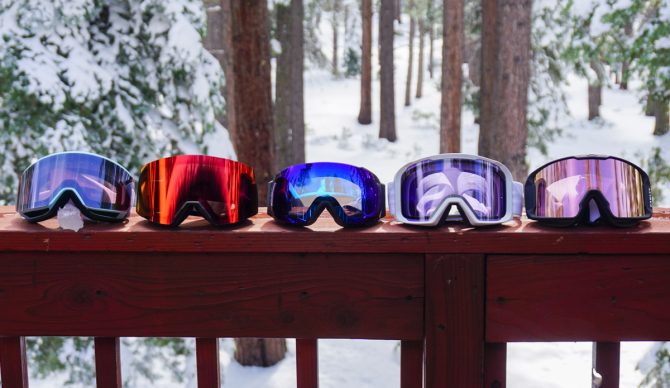
Testing options from Giro, Glade, Smith, Sweet Protection, and Oakley, side by side. Photo: Will Sileo//The Inertia
How We Tested The Best Snowboard Goggles
Our team here at The Inertia has spent the past three seasons testing snowboard goggles. During the legendary 2022/23 winter season, we got our hands on the best snowboard goggles available and had Steve Andrews put them through the wringer in the Coast Mountains of British Columbia (home to Whistler/Blackcomb). Through a number of classic “wet coast” storm cycles, Steve put these goggles to the ultimate test. During one storm, the humidity was at a minimum of 96%, and the temperatures hovered around freezing, meaning the snow coming down barely qualified as snow. These are the perfect conditions for goggles to fog up, so Steve was able to put the gear through an intense testing process and created our first edition of this snowboard goggle review.
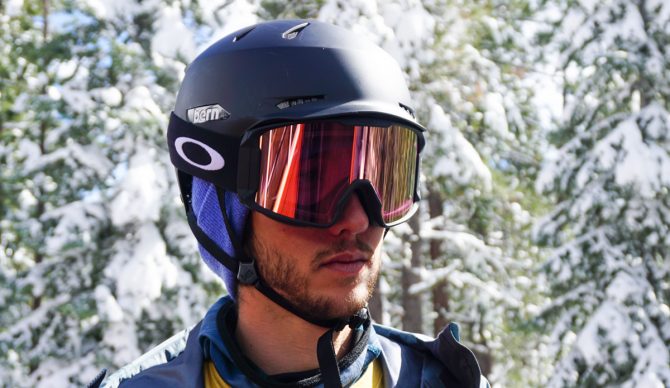
Oakley’s Line Miner goggles provide top-tier lens tech at an approachable price. Photo: Ken Cox//The Inertia
At the same time, Managing Gear Editor Will Sileo conducted colder-weather tests of top-pick models at locations like Jackson Hole, Wyoming, as well as during the insanely deep and quite cold winter that occurred that season in Lake Tahoe. In the 2023/24 winter season, we continued our coverage with another very wet winter in the PNW, giving us ideal conditions to put more snowboard goggles to the ultimate test. Last 24/25 season, we continued testing a few more new options, such as Smith’s new photochromic lenses, and continued longer-term testing of our top picks. The results of this testing are what you see above.
This season, we will continue our testing of the current lineup of goggles, as well as some exciting new options from Smith, Oakley, Outdoor Master, and others. We’re stoked to keep this article updated throughout the season to keep you, our readers, informed with the most accurate and up-to-date information.

Heavy, wet snow and humid conditions are par for the course in coastal BC. Photo: Steve Andrews//The Inertia
Testing Criteria
We believe the ultimate test of whether a pair of goggles can be considered among the best is going out and snowboarding in all conditions. The body gets warm when shredding hard, and when it’s cold out, the contrast between the inside and outside of the goggles is where the rubber meets the road. Goggles that don’t hold up can even start to freeze on the outside or get damp on the inside – both situations that will mess up one’s vision enough to have a bad day. So when riding, the main consideration was: can you see out of these even when the going gets tough? That said, a number of other factors go into a good pair of goggles. For this review, we looked at:
Lens quality in the aforementioned conditions: Being able to see is one thing, but can the lens enhance the experience? A number of brands make the claim, and in this guide, we only mention the ones that truly do have something special in the vision quality.
Lens swap-ability: Even the best of us can bail hard and have the lens fill up with snow. In that case, you’ll need to change lenses on the fly. Can you easily swap lenses on the side of the slope when it’s puking snow? For every pair, if the lenses could swap, we tried it out in the elements when every second matters.
Strap durability: Because these straps are elastic, they will often wear out over time. So the goal was to take them on and off the head as often as possible, seeing how well the strap could hold up in time. This is a big differentiator in a cheap pair over a more expensive one, and a good one to consider where the cheapest option might not be so cheap in the long run if the straps are wearing out every couple of months.
Fog-ability, or lack thereof: How easily can the fog fill up the goggles? Really, there is no 100% safeguard against fog. It’ll happen sooner or later to every pair. What really makes a pair stand out, though, is how soon the fog can clear from the lens to get you back to riding without having to mess up the coating inside by wiping it off.
Overall look and feel: A subjective category, but important nonetheless! Goggles can be a fun fashion piece as well as protecting your eyes from the elements. Why not look good while keeping the sun and snow out of your eyes?

Dragon’s NFX MAG IR showing off its infrared-blocking properties with the violet tint. Photo: Steve Andrews//The Inertia
Snowboard Goggles Buyer’s Guide
It’s easy to get sucked into the cheap goggle trap — after all, it’s just a piece of plastic in front of your face, right? Wrong. That lens is probably packed with as much tech as the snowboard under your feet — or at least it should be. Good goggles make use of double-layer constructions, anti-fog coatings to keep the mist at bay, contrast-boosting lens technology, and a wide array of tints to help you adjust to different lighting conditions.
In other words, there are a lot of different factors that go into making the perfect pair of snowboard goggles for your needs. Here, we do our best to break down the jargon so you can determine what matters to you and what doesn’t, whether or not that fancy lens technology actually improves your vision, what type of lens you should be rocking for your face shape and size, and much more.

When it comes to lens quality, it’s hard to beat Smith. Photo: Steve Andrews//The Inertia
Lens Shape
Snowboard goggles tend to come in three different shapes of lenses: cylindrical, spherical, and toric.
Cylindrical lenses are the classic lens shape for goggles, with a flat curve like the wall of a cylinder. This produces the most low-profile fit but often has a reduced field-of-view when compared to other lens shapes.
Spherical lenses bulge out a bit more, like a sphere, increasing peripheral vision, but that can come at the cost of a bit of a bug-eyed look.
Toric lenses take the best of both worlds with the field-of-view of a spherical lens, but the lower-profile look of a cylindrical lens. They’re also said to best fit the shape of the human face. Smith’s 4D Mag takes it a step further with beveled edges, producing a much wider field of view in a lower-profile shape.

Left to Right: Oakley, Anon, Dragon, Sweet Protection. Photo: Steve Andrews//The Inertia
Lens Quality/Contrast-Boosting Technology
We’ll get into different tint categories, below, which line up with various levels of brightness to help you choose the right lens for the conditions you’re skiing in. Here, we’ll briefly touch on contrast-boosting technology.
All of the major brands have their own secret recipe of tinting and filters made to boost contrast and help you see the details in the snow under your feet. This is especially helpful on flat-light days. Our eyes rely on contrast and shadows to see the small undulations, ice, soft patches, etc, on the surface of the snow. When the sky is grey and shadows disappear, the terrain becomes one big white sheet, and it can feel like you’re skiing blind.
Contrast-boosting lenses do what the name suggests by filtering out specific wavelengths of light while boosting others, to help your eyes pick out the cues that suggest “here’s a bump” or “here’s a dip” that would otherwise all look the same in that washed-out flat light. We found Smith’s Chromapop in the 4D Mag and I/O Mag, and Oakley’s Prizm (such as in the Line Miner) to be our favorites. Sweet Protection’s Rig technology, Anon’s Perceive, and Dragon’s Lumalens are close runners-up.
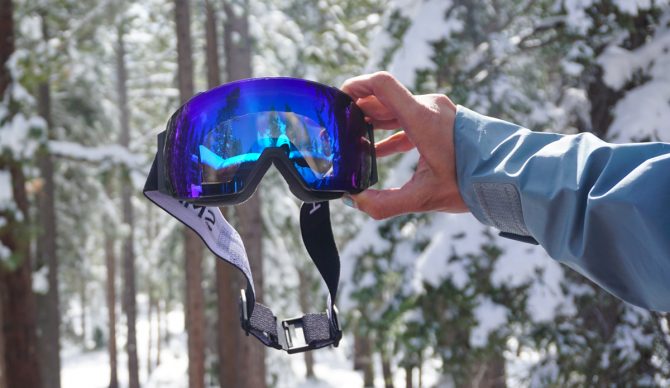
In lower-light conditions, a photocromic lens lightens to let in more light… Photo: Ken Cox//The Inertia
VLT
VLT stands for Visual Light Transmission, which simply translates to how much light a specific lens lets in to reach your eyes. This is expressed in percentages, with higher VLT percentages letting in more light and lower percentages letting in less. High VLT lenses (around 40-80%) are best for lower-light conditions, and low VLT lenses (5-25%) are better for bright, sunny conditions. Lens tint categories (below) provide a useful standard for easily determining what lens is best for the conditions on hand. Photocromic lenses have VLT ranges (say 48%-7%) which describe how much the lens tint can shift to adapt to the conditions.
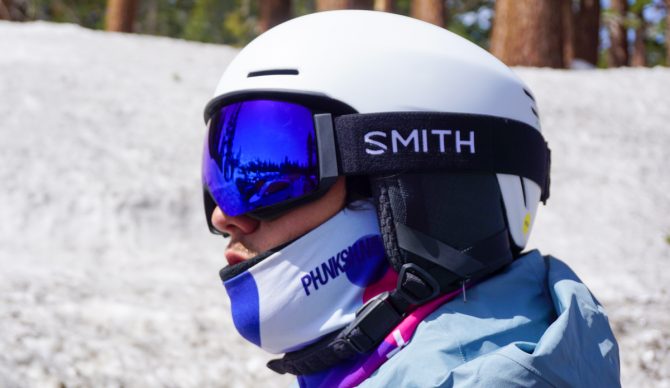
… And darkens in higher-light conditions to protect your eyes and reduce glare. Photo: Ken Cox//The Inertia
Lens Tint Categories
Lens tints are categorized from 0 to 4 to help standardize what conditions a specific lens is best for.
Category 0 (~70-100% VLT): Cat 0 lenses don’t block much light, if any. Clear, or very lightly tinted, these are best for night skiing or extremely stormy, whiteout conditions.
Category 1 (~40-70%): Cat 1 lenses are very lightly tinted, letting in a lot of light, but being optimized for low or flat-light conditions, this is truly where the rubber meets the road in terms of contrast-boosting technology. For goggles that include a second “low-light lens,” it’s usually a cat 1 lens.
Category 2 (~18-40%): Cat 2 lenses are the most common sort of everyday mixed-light lens that works in just about all conditions. Easily the most versatile, these lenses bridge the gap between low-light and bright-light lenses, but they’re most at home on partly cloudy days.
Category 3 (~8-18%): Cat 3 lenses are your typical bright sun/bluebird day lenses. They’ll certainly suffice in mixed light, but will struggle in low-light conditions.
Category 4 (~3-8%): Cat 4 lenses are rarely found on resort skiing goggles, and are mainly reserved for mountaineering glacier glasses and the like. Letting in a very, very small amount of light, they are best for very bright conditions, such as glaciated terrain.
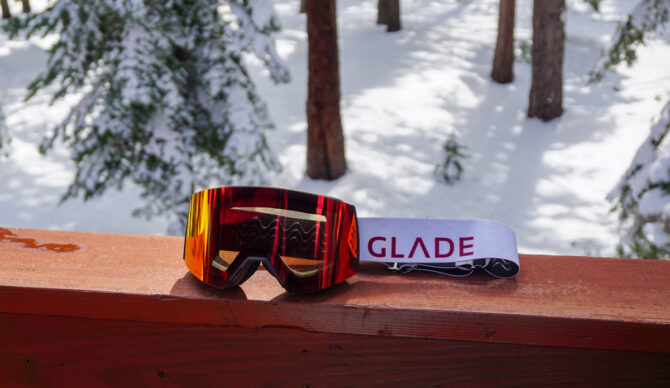
Glade’s photocromic lenses are top-tier, and somehow don’t break the bank. Photo: Will Sileo//The Inertia
Photocromic Lenses
Photocromic goggle lenses adapt to the ambient UV light around them. For example, a typical photochromic lens might shift from 30 – 60% VLT, effectively moving from a Cat 1 low-light lens to a Cat 2 all-around lens. Other versions might go from Cat 2 to Cat 3 for partly cloudy to bright sun. While photocromic lenses offer one-lens versatility, they’re not as optimized at the extreme ends as dedicated low-light or bright-sun lenses.
In the past, they also took time to adjust, meaning they weren’t the best for ducking in/out of trees, and could be affected by temperature as well, being slower to lighten if it’s cold out. This is improving, with brands like Glade and Smith leading the charge, but cheaper photocromic goggles may still fall prey to these downsides.
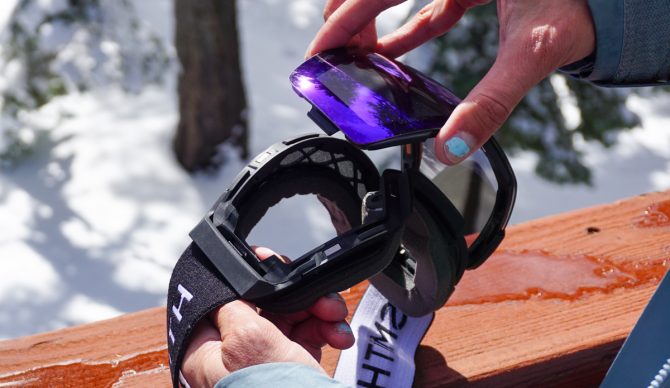
Magnets and a secure click-in frame provide easy lens-swapping and lock in so you don’t lose your lens when you take a tumble. Photo: Ken Cox//The Inertia
Lens Swapping
For some, simple is better. No lens change, no BS, just snowboarding. For others (our testing crew included), it is a huge plus to have interchangeable lenses for tackling goggle fog and adapting to different light conditions. Easy swapability is key, so a combination of magnetic and locking, such as that found in the Dragon NFX Mag and Smith 4D Mag, makes for easy changing that won’t come undone without a major fight.
Other goggles, such as the Glade Adapt 2, are photochromic, meaning the lens adapts to changing light conditions. This is ideal when the weather comes in and out, and you don’t want to be wasting precious time changing your lenses every time a cloud goes across the sun.
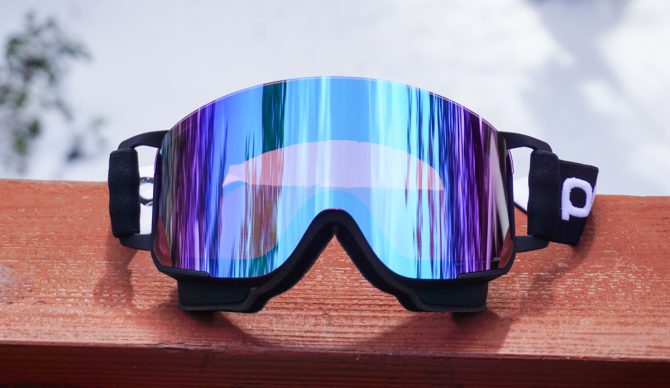
POC’s Nexal Goggles use strap outriggers to help the goggles sit closer to your face. Photo: Will Sileo//The Inertia
Goggle Strap
You want to have a good strap that won’t wear out and lose its elasticity. If buying used, check for wear and tear around the temples and in the back. It’s annoying when a strap breaks. All of the goggles included here (and almost every goggle on the market) use elastic straps for a tighter fit, and some (such as the Smith 4D Mag) have a quick-release in the back to easily take the goggles off with a helmet on.

Features like Anon’s magnetic facemask can elevate a pair of goggles above the competition. Photo: Steve Andrews//The Inertia
Other Features
A good case can also make a big difference in ensuring your goggles will stand the test of time, especially during travel and storage. Big ups to the Anon M5 here, as they also include a slimmer-profile lens case to protect your extra lens while on the mountain. This means you can shove that extra lens in a pocket worry-free and swap it out as needed.
Comfort also matters, as there’s nothing worse than having to deal with the annoyance of an uncomfortable piece of plastic on your face while you’re trying to have fun. A big consideration for comfort is whether you’ll be wearing a helmet and if the curve of your helmet matches up with the curve of your goggles. Nobody wants a gaper gap, both for the discomfort it will cause and the sideways glances. Smith and POC also make helmets, and so their integrations with their respective goggles make for a more seamless fit when used together.
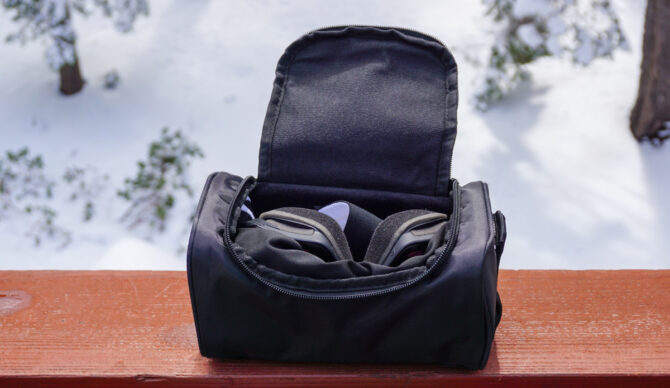
If your goggles come with a case, be sure to store them inside of it after wearing them, no matter how tired you are. Photo: Will Sileo//The Inertia
Taking Care of Your Snowboard Goggles
Regardless of what goggles you end up with, make sure you take care of them. Here are a few tips to make sure your investment lasts a long time. Following these guidelines will ensure that they last for many seasons to come, no matter what you or Mother Nature throws at them.
Don’t put them on your forehead when not in use. After sweating it out under a beanie or helmet, your head is usually pretty damp, so the moisture will get into the foam and cause the goggles to fog up and, over time, smell pretty bad.

Smith’s ChromaPop vision quality is the real deal. Photo: Steve Andrews//The Inertia
Don’t rub the inside of the lens when it’s wet/fogged. Most of the good lenses have an anti-fog coating on the inside. Try to fight the urge to wipe away any fog and let it dissipate naturally. The best way to do this is inside your jacket. Most jackets these days have a large pocket for that reason. Or, try to keep a spare lens with you so that you can easily change it if they do fog up.
If the goggles aren’t covering your eyes, try to stash them in a pocket in their protective sleeve. If you have a helmet, it’s OK to rest them on your helmet, but make sure you loosen the straps, so they don’t stretch out. And please, don’t leave them stretched out around the rim of your helmet overnight.
When finished riding, make sure they have ample time to air out before storing them. The worst thing you can do is trap moisture inside for an extended period of time. Not only will they start to smell bad, but they will fog up more easily if you do so, as the interior anti-fog coating wears away faster. Separating the lenses from the frame to ensure full drying is also a good idea, but a little overkill.

Goggles should work with a helmet, a hat, or both – especially for snowboarding. Photo: Steve Andrews//The Inertia
Final Thoughts
When it comes to goggles, you can’t really go wrong with the top brands. They have all been doing it for quite some time and have had plenty of opportunities to learn and improve their products over the years. So it often comes down to the subtle differences that are most important to the individual. Hopefully, we have distilled that down a bit more for you here. So go out, have fun, be safe, and look good while doing so!
Return to Top Picks | Return to Comparison Table
Related: Best Snowboards | Best Snowboard Pants | Best Snowboard Jackets | More Winter Reviews
Editor’s Note: For more gear reviews and features on The Inertia, click here.




